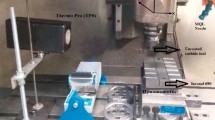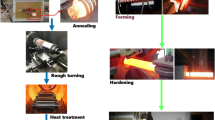Abstract
The present research focuses on establishing a sustainable manufacturing paradigm through the development of a model for optimizing machining parameters under a minimum quantity lubricating environment. The variables considered for investigation encompass cutting speed, feed, and depth of cut. To gauge the sustainability, five key indicators were assessed: total energy consumption, total carbon emission, total machining cost, surface roughness, and tool wear incurred during the machining of Inconel 690. Besides, in order to proficiently oversee machining parameters, the essential integration of modeling and optimization strategies assumes paramount significance. Consequently, a combined approach employing Gene Expression Programming (GEP) in conjunction with Particle Swarm Optimization (PSO) was adopted. GEP was employed to model the observed outcomes in relation to the design variables. Subsequently, the PSO technique was applied to ascertain the optimal configuration of machining parameters. Notably, a confirmation test demonstrated a minimal average discrepancy (less than 3%) between the experimental and GEP-PSO predicted results, showcasing the robustness of the hybrid optimization approach. Finally, machining with silica-doped sunflower oil in optimized machining conditions yields 20% energy reduction, 18.68% lower carbon emissions, an 11.76% cost decrement, a 20.21% reduction in surface roughness, and a 31.71% drop in tool wear, as compared to dry machining, making it an eco-friendly and cost-effective option for superalloy machining.



















Similar content being viewed by others
Data availability
Not applicable.
Code availability
Not applicable.
References
Khan AM, Liang L, Mia M, Gupta MK, Wei Z, Jamil M, Ning H (2021) Development of process performance simulator (PPS) and parametric optimization for sustainable machining considering carbon emission, cost, and energy aspects. Renew Sustain Energy Rev 139:110738
Sen B, Yadav SK, Kumar G, Mukhopadhyay P, Ghosh S (2023) Performance of eco-benign lubricating/cooling mediums in machining of superalloys: a comprehensive review from the perspective of Triple Bottom Line theory. Sustainable Materials and Technologies, e00578.
Lin B, Chen G (2018) Energy efficiency and conservation in China’s manufacturing industry. J Clean Prod 174:492–501
National NBS. Bureau of statistics of China. 2019.
Dahmus JB, Gutowski TG (2004) An environmental analysis of machining. In ASME Int Mechan Eng Cong Exposition 47136:643–652
Jamil M, Zhao W, He N, Gupta MK, Sarikaya M, Khan AM, ... Pimenov DY (2021) Sustainable milling of Ti–6Al–4V: A trade-off between energy efficiency, carbon emissions and machining characteristics under MQL and cryogenic environment. Journal of cleaner production, 281, 125374.
Li L, Li C, Tang Y, Yi Q (2017) Influence factors and operational strategies for energy efficiency improvement of CNC machining. J Clean Prod 161:220–238
Zhou L, Li J, Li F, Meng Q, Li J, Xu X (2016) Energy consumption model and energy efficiency of machine tools: a comprehensive literature review. J Clean Prod 112:3721–3734
Li C, Tang Y, Cui L, Li P (2015) A quantitative approach to analyze carbon emissions of CNC-based machining systems. J Intell Manuf 26:911–922
Yi Q, Tang Y, Li C, Li P (2013) Optimization of CNC machine processing parameters for low carbon manufacturing. In 2013 IEEE International Conference on Automation Science and Engineering (CASE) (pp. 498–503). IEEE.
Branker K, Adams D, Jeswiet J (2012) Initial analysis of cost, energy and carbon dioxide emissions in single point incremental forming–producing an aluminium hat. Int J Sustain Eng 5(3):188–198
Rapeti P, Pasam VK, Gurram KMR, Revuru RS (2018) Performance evaluation of vegetable oil based nano cutting fluids in machining using grey relational analysis-a step towards sustainable manufacturing. J Clean Prod 172:2862–2875
Amigo FJ, Urbikain G, Pereira O, Fernández-Lucio P, Fernández-Valdivielso A, de Lacalle LL (2020) Combination of high feed turning with cryogenic cooling on Haynes 263 and Inconel 718 superalloys. J Manuf Process 58:208–222
Pérez-Ruiz JD, de Lacalle LNL, Urbikain G, Pereira O, Martínez S, Bris J (2021) On the relationship between cutting forces and anisotropy features in the milling of LPBF Inconel 718 for near net shape parts. Int J Mach Tools Manuf 170:103801
Pereira O, Celaya A, Urbikaín G, Rodríguez A, Fernández-Valdivielso A, de Lacalle LNL (2020) CO2 cryogenic milling of Inconel 718: cutting forces and tool wear. J Market Res 9(4):8459–8468
Pereira O, Martín-Alfonso JE, Rodríguez A, Calleja A, Fernández-Valdivielso A, De Lacalle LL (2017) Sustainability analysis of lubricant oils for minimum quantity lubrication based on their tribo-rheological performance. J Clean Prod 164:1419–1429
Pereira O, Rodríguez A, Barreiro J, Fernández-Abia AI, de Lacalle LNL (2017) Nozzle design for combined use of MQL and cryogenic gas in machining. Int J Precision Eng Manufact -green Technol 4:87–95
Erhan SZ, Sharma BK, Perez JM (2006) Oxidation and low temperature stability of vegetable oil-based lubricants. Ind Crops Prod 24(3):292–299
dos Santos Politi JR, de Matos PRR, Sales MJA (2013) Comparative study of the oxidative and thermal stability of vegetable oils to be used as lubricant bases. J Therm Anal Calorim 111:1437–1442
Grompone MA (2011) Sunflower oil. Vegetable oils in food technology. Oxford: Wiley-Blackwell. 137–67.
Chaudhari R, Vora J, López de Lacalle LN, Khanna S, Patel VK, Ayesta I (2021) Parametric optimization and effect of nano-graphene mixed dielectric fluid on performance of wire electrical discharge machining process of Ni55. 8Ti shape memory alloy. Materials. 14(10):2533.
Wang Y, Li C, Zhang Y, Yang M, Li B, Jia D, ... Mao C (2016) Experimental evaluation of the lubrication properties of the wheel/workpiece interface in minimum quantity lubrication (MQL) grinding using different types of vegetable oils. Journal of Cleaner Production. 127, 487–499.
Sen B, Mia M, Mandal UK, Mondal SP (2019) GEP-and ANN-based tool wear monitoring: a virtually sensing predictive platform for MQL-assisted milling of Inconel 690. The Int J Adv Manufact Technol 105:395–410
Sen B, Hussain SAI, Gupta MK, Mia M, Mandal UK (2021) Swarm intelligence based selection of optimal end-milling parameters under minimum quantity nano-green lubricating environment. Proc Inst Mech Eng C J Mech Eng Sci 235(23):6969–6983
Sen B, Mia M, Mandal UK, Mondal SP (2020) Synergistic effect of silica and pure palm oil on the machining performances of Inconel 690: A study for promoting minimum quantity nano doped-green lubricants. J Clean Prod 258:120755
Usluer E, Emiroğlu U, Yapan YF, Kshitij G, Khanna N, Sarıkaya M, Uysal A (2023) Investigation on the effect of hybrid nanofluid in MQL condition in orthogonal turning and a sustainability assessment. Sustain Mater Technol 36:e00618
Saatçi E, Yapan YF, Uysal MU, Uysal A (2023) Orthogonal turning of AISI 310S austenitic stainless steel under hybrid nanofluid-assisted MQL and a sustainability optimization using NSGA-II and TOPSIS. Sustain Mater Technol 36:e00628
Wang H, Bai Q, Chen S, Wang P, Guo W, Dou Y (2023) Wear suppression and interface properties of diamond tool in micro-milling of TC4 alloy under graphene nanofluid MQL environment. Journal of Cleaner Production, 138180.
Danish M, Gupta MK, Rubaiee S, Ahmed A, Sarıkaya M, Krolczyk GM (2022) Environmental, technological and economical aspects of cryogenic assisted hard machining operation of inconel 718: A step towards green manufacturing. J Clean Prod 337:130483
Gupta MK, Song Q, Liu Z, Sarikaya M, Jamil M, Mia M, ... Pimenov DY (2021) Environment and economic burden of sustainable cooling/lubrication methods in machining of Inconel-800. Journal of cleaner production, 287, 125074.
Ross NS, Rai R, Ananth MBJ, Srinivasan D, Ganesh M, Gupta MK, ... Królczyk GM (2023) Carbon emissions and overall sustainability assessment in eco-friendly machining of Monel-400 alloy. Sustainable Materials and Technologies, e00675.
Raval P, Patel D, Prajapati R, Badheka V, Gupta MK, Khanna N (2022) Energy consumption and economic modelling of performance measures in machining of wire arc additively manufactured Inconel-625. Sustain Mater Technol 32:e00434
Buj-Corral I, Sender P, Luis-Pérez CJ (2023) Multi-objective optimization of tool wear, surface roughness, and material removal rate in finishing honing processes using adaptive neural fuzzy inference systems. Tribol Int 182:108354
Yu W, Ming W, An Q, Chen M (2023) Wear behavior of SiAlON ceramic tool and its effects during high-speed cutting. Ceramics International.
Chen B, Yusuf M, Hashimoto T, Estandarte AK, Thompson G, Robinson I (2017) Three-dimensional positioning and structure of chromosomes in a human prophase nucleus. Sci Adv 3(7):e1602231
Colantuoni C, Purcell AE, Bouton CM, Pevsner J (2000) High throughput analysis of gene expression in the human brain. J Neurosci Res 59(1):1–10
Ahmad M, Jung LT, Bhuiyan AA (2017) From DNA to protein: Why genetic code context of nucleotides for DNA signal processing? A review. Biomed Signal Process Control 34:44–63
Jacques M, Hiam D, Craig J, Barrès R, Eynon N, Voisin S (2019) Epigenetic changes in healthy human skeletal muscle following exercise–a systematic review. Epigenetics 14(7):633–648
Kayadelen C, Günaydın O, Fener M, Demir A, Özvan A (2009) Modeling of the angle of shearing resistance of soils using soft computing systems. Expert Syst Appl 36(9):11814–11826
Algaifi HA, Alqarni AS, Alyousef R, Bakar SA, Ibrahim MW, Shahidan S, ... Salami BA (2021) Mathematical prediction of the compressive strength of bacterial concrete using gene expression programming. Ain Shams Engineering Journal, 12(4), 3629–3639.
Mousavi SM, Aminian P, Gandomi AH, Alavi AH, Bolandi H (2012) A new predictive model for compressive strength of HPC using gene expression programming. Adv Eng Softw 45(1):105–114
Jain M, Saihjpal V, Singh N, Singh SB (2022) An overview of variants and advancements of PSO algorithm. Appl Sci 12(17):8392
Jewell WT, Ramakumar R, Hill SR (1988) A study of dispersed photovoltaic generation on the PSO system. IEEE Trans Energy Convers 3(3):473–478
Soepangkat BOP, Norcahyo R, Effendi MK, Pramujati B (2020) Multi-response optimization of carbon fiber reinforced polymer (CFRP) drilling using back propagation neural network-particle swarm optimization (BPNN-PSO). Engineering Science and Technology, an International Journal 23(3):700–713
Kennedy J, Eberhart R (1995) Particle swarm optimization. In Proceedings of ICNN’95-international conference on neural networks. 4:1942–1948). IEEE.
Mia M, Dhar NR (2017) Optimization of surface roughness and cutting temperature in high-pressure coolant-assisted hard turning using Taguchi method. The Int J Adv Manufact Technol 88:739–753
Mia M, Razi MH, Ahmad I, Mostafa R, Rahman SM, Ahmed DH, ... Dhar NR (2017) Effect of time-controlled MQL pulsing on surface roughness in hard turning by statistical analysis and artificial neural network. The International Journal of Advanced Manufacturing Technology, 91, 3211–3223.
St L, Wold S (1989) Analysis of variance (ANOVA). Chemom Intell Lab Syst 6(4):259–272
Badiger PV, Desai V, Ramesh MR, Prajwala BK, Raveendra K (2019) Cutting forces, surface roughness and tool wear quality assessment using ANN and PSO approach during machining of MDN431 with TiN/AlN-coated cutting tool. Arab J Sci Eng 44(9):7465–7477
Şencan AÇ, Şirin Ş, Saraç ENS, Erdoğan B, Koçak MR (2023) Evaluation of machining characteristics of SiO2 doped vegetable based nanofluids with Taguchi approach in turning of AISI 304 steel. Tribology International, 109122.
Makhesana MA, Baravaliya JA, Parmar RJ, Mawandiya BK, Patel KM (2021) Machinability improvement and sustainability assessment during machining of AISI 4140 using vegetable oil-based MQL. J Braz Soc Mech Sci Eng 43:1–14
Singh H, Sharma VS, Dogra M (2020) Exploration of graphene assisted vegetables oil based minimum quantity lubrication for surface grinding of TI-6AL-4V-ELI. Tribol Int 144:106113
Acknowledgements
The authors gratefully acknowledge Chennai Institute of Technology, Chennai, India, vide funding number CIT/CNS/2023/RP-016 for providing financial assistance to carry out this work.
Author information
Authors and Affiliations
Contributions
All the authors have contributed equally.
Corresponding author
Ethics declarations
Ethics approval
Not applicable.
Consent to participate
Not applicable.
Consent for publication
Not applicable.
Competing interests
The authors declare no competing interests.
Additional information
Publisher's Note
Springer Nature remains neutral with regard to jurisdictional claims in published maps and institutional affiliations.
Rights and permissions
Springer Nature or its licensor (e.g. a society or other partner) holds exclusive rights to this article under a publishing agreement with the author(s) or other rightsholder(s); author self-archiving of the accepted manuscript version of this article is solely governed by the terms of such publishing agreement and applicable law.
About this article
Cite this article
Sen, B., Debnath, S. & Bhowmik, A. Sustainable machining of superalloy in minimum quantity lubrication environment: leveraging GEP-PSO hybrid optimization algorithm. Int J Adv Manuf Technol 130, 4575–4601 (2024). https://doi.org/10.1007/s00170-024-12962-9
Received:
Accepted:
Published:
Issue Date:
DOI: https://doi.org/10.1007/s00170-024-12962-9




